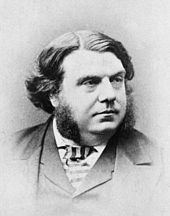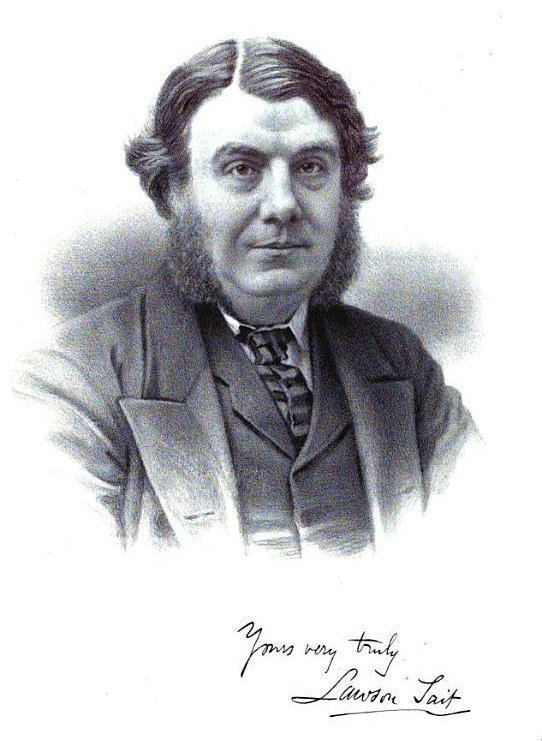Nationality Scotland | Name Lawson Tait | |
 | ||
Residence Birmingham, United Kingdom Fields | ||
Influenced by James Young Simpson | ||
Lawson Tait, born Robert Lawson Tait (1 May 1845 – 13 June 1899) was a pioneer in pelvic and abdominal surgery and developed new techniques and procedures. He emphasized asepsis and introduced and advocated for surgical techniques that significantly reduced mortality. He is well known for introducing salpingectomy in 1883 as the treatment for ectopic pregnancy, a procedure that has saved countless lives since then. Tait and J. Marion Sims are considered the fathers of gynecology.
Contents
- Early life and education
- Early Work
- Vivisection
- Asepsis
- Reducing surgical mortality
- Surgical milestones
- Ectopic pregnancy
- Later life
- Legacy
- References

Early life and education

Tait was born in Edinburgh, Scotland, the son of Archibald Campbell Tait, a lawyer, and Isabella Stewart Lawson, of Leven. He attended primary school at an independent school called Heriot’s Hospital, where he showed exceptional promise. In 1860, the 15-year-old Tait won a scholarship and attended the University of Edinburgh as a student of Arts. He subsequently changed course to study medicine. Among his greatest influences was James Syme, the University's Chair of Clinical Surgery. Tait considered Syme to be a remarkable surgeon who emphasized care and cleanliness, and he particularly admired Syme's taste for controversy. One of Syme's closest students was Joseph Lister, with whom Tait would later have significant disputes with over the rivaling practices of Antisepsis and Asepsis. Tait graduated and received his Licentiate of the Royal College of Physicians in 1866. He did not receive a Bachelor of Medicine degree.
Early Work
Tait worked as a resident surgeon at the Clayton Hospital in Wakefield as a resident surgeon from 1866 until 1870, when he took over a private practice in Birmingham. He became an active member of the British Medical Association, and in this position became known as an "offensive and invidious". Members of the group saw him as antagonistic and overstepping his place. Despite this opposition, Tait desired acceptance in London. As such, he attended meetings in London societies and pursued a fellowship at the Obstetrical Society of London.

From around this time until 1879 he also took a job at Midland Institute as a physiology and biology lecturer. In addition, Tait devoted significant efforts towards supporting Arthur Chamberlain, who was working on developing a hospital exclusively for women. Chamberlain and Tait were successful, and Tait worked as a member of this hospital's staff until 1893, when he resigned.
Vivisection

Tait was a strong and outspoken opponent of Vivisection, the practice of surgery on animals for the sake of instruction and practice. He argued that there were four strong arguments against this practice:
Asepsis
Tait was suspicious of the prevailing practice of antisepsis, advocated for by Joseph Lister. The two doctors agreed that it was necessary for surgeons to ensure that their hands and instruments were clean in order to reduce the risk of infection. Lister argued that surgical cleanliness could only be achieved through sterilization, which required the use of compounds like carbolic acid. Unlike Lister, Tait used nothing more than boiling water for cleaning his instruments and yet had similar results. Tait was able to achieve exceptional results in his surgery using his techniques, as they were simple, low-cost, effective, and not limited by the presence of chemicals.
Reducing surgical mortality
Tait's first success came with his demonstration that ovariotomy could be done safely. While Ephraim McDowell had successfully performed the first ovariotomy in Kentucky in 1809, mortality for this operation was over 90%. In his first paper in 1872, Tait reported only 1 death out of nine cases, a major breakthrough. His techniques of use of intraabdominal ligatures for the ovarian pedicle in favor of an extraperitoneal clamp, abdominal closure, and meticulous surgical cleanliness were novel and important for abdominal surgery. With further recognition, he was instrumental in the opening of the Birmingham Hospital for Women where he worked for 20 years.
Surgical milestones
During this time, his work included:
- First removal of an organ (ovary) (oophorectomy) for pain.
- Observation of association of cystic ovaries and excessive menstrual bleeding.
- Surgical induction of menopause by removal of ovaries.
- Removal of infected tubes.
- Drainage of pelvic abscess.
- First appendectomy 1880. It was later learned that he was anticipated by French-born English surgeon Claudius Amyand in 1735.
- First cholecystotomy (gallbladder surgery).
- Asepsis in lieu of Lister's antisepsis; he avoided the use of carbolic acid.
- Flushing of peritoneal cavity at end of operation.
Ectopic pregnancy
In 1881, it was suggested to him to remove the ruptured tube in case of an ectopic pregnancy. "... the suggestion staggered me, and I am ashamed to say that I did not receive it favorably." The postmortem examination convinced him that it could be done. So, 2 years later, Tait ligated the broad ligament and tube in another patient, and this patient survived. In 1888, Tait reported only 2 deaths out of 42 operated cases, a marked improvement for a condition that had been almost always fatal.
Later life
Tait's career began to decline in 1892. Due to his lifelong history of advocating for new techniques and against common practices (e.g. vivisection and antisepsis), there were many who saw him as an enemy and a nuisance. Tait’s productivity slowed to a halt due to his declining health, along with two legal situations. The first of these was a lawsuit from Andrew Denholm, and the second was a threat to bring action against Tait for supposedly seducing a nurse.
In his retirement, Tait continued to stay active within medicine. Many younger doctors respected and admired him, and he regularly contributed to meetings at several Medical Institutions. He died in 1899, at the age of 54, of chronic Nephritis and Uremia, after a week and a half of severe illness. He remained lucid in his final days, and left instructions that his body be buried in a cave near his home. At the time of his death, several of his contemporaries published writings in praise of his medical advances, character, and work at hospitals for poor women.
Legacy
The Lawson Tait Society, an undergraduate history of medicine society at the University of Birmingham Medical School, is named in honour of Tait. They have embarked upon a project of digitising Tait's work and resources related to Tait.
